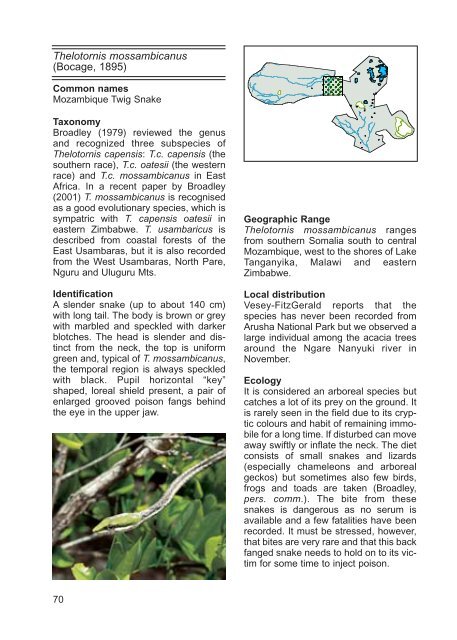field guide to the amphibians and reptiles of arusha national park
field guide to the amphibians and reptiles of arusha national park
field guide to the amphibians and reptiles of arusha national park
You also want an ePaper? Increase the reach of your titles
YUMPU automatically turns print PDFs into web optimized ePapers that Google loves.
Thelo<strong>to</strong>rnis mossambicanus<br />
(Bocage, 1895)<br />
Common names<br />
Mozambique Twig Snake<br />
Taxonomy<br />
Broadley (1979) reviewed <strong>the</strong> genus<br />
<strong>and</strong> recognized three subspecies <strong>of</strong><br />
Thelo<strong>to</strong>rnis capensis: T.c. capensis (<strong>the</strong><br />
sou<strong>the</strong>rn race), T.c. oatesii (<strong>the</strong> western<br />
race) <strong>and</strong> T.c. mossambicanus in East<br />
Africa. In a recent paper by Broadley<br />
(2001) T. mossambicanus is recognised<br />
as a good evolutionary species, which is<br />
sympatric with T. capensis oatesii in<br />
eastern Zimbabwe. T. usambaricus is<br />
described from coastal forests <strong>of</strong> <strong>the</strong><br />
East Usambaras, but it is also recorded<br />
from <strong>the</strong> West Usambaras, North Pare,<br />
Nguru <strong>and</strong> Uluguru Mts.<br />
Identification<br />
Aslender snake (up <strong>to</strong> about 140 cm)<br />
with long tail. The body is brown or grey<br />
with marbled <strong>and</strong> speckled with darker<br />
blotches. The head is slender <strong>and</strong> distinct<br />
from <strong>the</strong> neck, <strong>the</strong> <strong>to</strong>p is uniform<br />
green <strong>and</strong>, typical <strong>of</strong> T. mossambicanus,<br />
<strong>the</strong> temporal region is always speckled<br />
with black. Pupil horizontal “key”<br />
shaped, loreal shield present, a pair <strong>of</strong><br />
enlarged grooved poison fangs behind<br />
<strong>the</strong> eye in <strong>the</strong> upper jaw.<br />
70<br />
Geographic Range<br />
Thelo<strong>to</strong>rnis mossambicanus ranges<br />
from sou<strong>the</strong>rn Somalia south <strong>to</strong> central<br />
Mozambique, west <strong>to</strong> <strong>the</strong> shores <strong>of</strong> Lake<br />
Tanganyika, Malawi <strong>and</strong> eastern<br />
Zimbabwe.<br />
Local distribution<br />
Vesey-FitzGerald reports that <strong>the</strong><br />
species has never been recorded from<br />
Arusha National Park but we observed a<br />
large individual among <strong>the</strong> acacia trees<br />
around <strong>the</strong> Ngare Nanyuki river in<br />
November.<br />
Ecology<br />
It is considered an arboreal species but<br />
catches a lot <strong>of</strong> its prey on <strong>the</strong> ground. It<br />
is rarely seen in <strong>the</strong> <strong>field</strong> due <strong>to</strong> its cryptic<br />
colours <strong>and</strong> habit <strong>of</strong> remaining immobile<br />
for a long time. If disturbed can move<br />
away swiftly or inflate <strong>the</strong> neck. The diet<br />
consists <strong>of</strong> small snakes <strong>and</strong> lizards<br />
(especially chameleons <strong>and</strong> arboreal<br />
geckos) but sometimes also few birds,<br />
frogs <strong>and</strong> <strong>to</strong>ads are taken (Broadley,<br />
pers. comm.). The bite from <strong>the</strong>se<br />
snakes is dangerous as no serum is<br />
available <strong>and</strong> a few fatalities have been<br />
recorded. It must be stressed, however,<br />
that bites are very rare <strong>and</strong> that this back<br />
fanged snake needs <strong>to</strong> hold on <strong>to</strong> its victim<br />
for some time <strong>to</strong> inject poison.

















